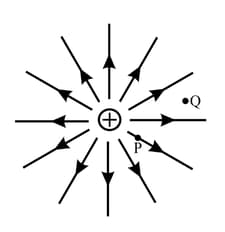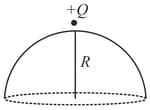Draw the equipotential surface due to a system of two identical positive charges.
Important Questions on Fields (HL)
The electric field lines of a positive charge is as shown in figure. What is the shape of equipotential surface near the charge ?

The equipotential surface through a point is normal to the electric field at that point.
What is meant by equipotential surface?
The equipotential surface through a point is normal to the electric field at that point.
Draw the equipotential surfaces for a uniform electric field.
Define:
Equipotential surface.
Draw equipotential surface due to an isolated point charge and depict the electric field lines.

The equipotential surface through a point is normal to the electric field at that point.
What is the work done to move a charge on an equipotential surface?
What is the direction of electric field with respect to an equipotential surface?

